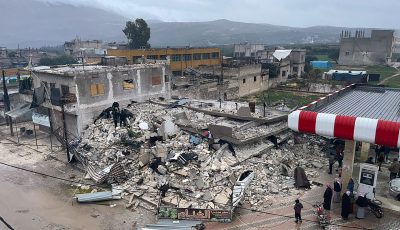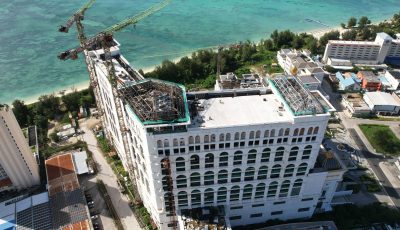BSI to hold public hearing on archeological finds today
»Over 400 remains found

Archeologists who did a study on Best Sunshine International’s site in Garapan will be presenting to the public today the preliminary findings on their study. In the photo are, from left, archeologist Vanessa Cabrera, BSI legal counsel Viola Alepuyo, and Scientific Consultant Services principal investigator Michael Dega. (Frauleine Villanueva-Dizon)
Archeologists who dug and made studies of the remains and artifacts found at the Garapan site of Best Sunshine International, Ltd. will be presenting to the public today a preliminary report on their findings on what they tout as “the largest data recovery project ever on Saipan.”
In a press conference, Scientific Consultant Services principal investigator Michael Dega reported that their 270-page preliminary draft was finished a month ago and was submitted to the Historic Preservation Office after about four months of digging and data recovery. Twelve archeologists, two of which are osteologists, worked on the site.
The site, which was called Anaguan, is an ancient village and burial site as early as 1300 A.D., and is said to be where the Spanish-Chamoru War happened in the 1660s.
According to the archeologists, the site had two main layers: a cultural layer where people used to live and a burial layer. No pre-latte period artifacts were found, and no evidence of Spanish settlement was also found.
Sling stones, fish hooks, jewelry, pottery, bone spears, stone and shell tools, basalt axes, and lusongs (mortar and pestle) are just some of the materials they found at the cultural layer.
Dega said the remains they found total to 416 MNIs or minimum numbers of individuals.
While most of the recovered artifacts found are on island and stored in a climate-controlled facility in Lower Base, Dega said charcoal samples were sent to Florida for carbon-dating, pottery samples were also sent off-island and, about 15 to 18 “small bags” of bones were sent to Idaho for DNA testing. These bones are still off island and being studied.
Testing made to the bones show that the population was healthy. As early as then, traces of beetle nut were found on the teeth of the people.
Largest bowl, American GI
Some of the more interesting findings include an overturned 3-foot ceramic bowl, which when lifted turned out to be covering the remains of a 3-year-old child. The bowl was said to be the “largest ceramic bowl ever found intact.”
It was found by Vanessa Cabrera, a homegrown archeologist from the island. Being able to unearth this finding of her own ancestors was an emotional experience for Cabrera.
“When I first found it, I saw that it was just the lady and the bowl. So I was thinking maybe she held some sort of status. But as I kept digging, I found the child,” Cabrera said.
Cabrera said the first thing she said was “You are beautiful.”
For her, despite some people’s views that unearthing the remains are disrespectful, it was an opportunity to learn more about herself and her ancestors. She was also able to get support from friends.
“I have friends messaged me saying, who better to do that than a local,” Cabrera said.
Another interesting finding the archeologist found was the remains of an American G.I. from World War II that was found to be of European decent. It was in the north central side of the site, away from the latte site.
Dega said the remains were flown out by the Defense POW/MIA Accounting Agency in Hawaii to find the relatives of the fallen soldier.
BSI legal counsel Viola Alepuyo said they have several options that they will present to the public on what to do with the remains and where they will be interred but they will let the people comment and voice out their opinions.
“Ultimately, it’s HPO that gets to decide,” Alepuyo said.
BSI will hold a public meeting today from 6pm to 8pm at the Pedro P. Tenorio Multi-Purpose Center and another one on Wednesday at Chacha Oceanview Middle School.
“We couldn’t have done it without Best Sunshine. They funded and they promoted and helped us do the largest data recovery project ever on Saipan. Without them this would never happened,” Dega said.



























